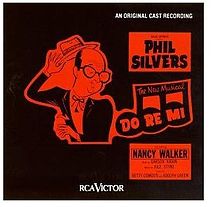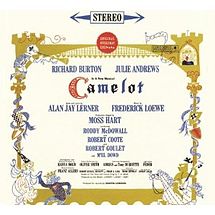
From Broadway To 52nd Street
No Strings opened the curtain at the 54th Street Theatre on March 15, 1962 and ran for 580 performances. The musical starred Richard Kiley and Diahann Carroll performing music composed by Richard Rodgers, and The Sweetest Sounds and Loads of Love went on to become part of the classic jazz lexicon.
The Story: In Paris, David Jordan, a prize-winning writer suffering from a long dry spell meets a black model, Barbara Woodruff. Their budding romance wilts when David learns that a wealthy admirer has kept Barbara. Later they resume their affair but after recognizing that an interracial marriage would be doomed, they go their separate ways.
Jazz History: When trumpeter Miles Davis, under the influence of James Brown, Sly Stone, and Jimi Hendrix, crossed over to a new rock-inflected form with his influential Bitches Brew album in 1970, the new sub-genre of jazz-rock fusion gained jazz legitimacy for about a decade. Numerous graduates of Davis’ experiment—including pianists Herbie Hancock, Keith Jarrett, Joe Zawinul, and Chick Corea, drummers Tony Williams and Jack DeJohnette, percussionist Airto Moreira, saxophonist Wayne Shorter, guitarist John McLaughlin, and bassist Dave Holland—went on to success as leaders or members of 70s fusion super groups like Weather Report, Return to Forever, Lifetime, and the Mahavishnu Orchestra. Fusion was followed by a lighter, radio-friendly style called smooth jazz, which ultimately diminished the legitimacy of fusion in the minds of jazz purists. Fusion was innovative in its time, however, for it brought electronics and a strong backbeat into jazz, while influencing an entire new generation to begin exploring the style.
Sponsored By
www.whatissuitetabu.com

From Broadway To 52nd Street
How To Succeed In Business Without Really Trying opened the 46th Street Theatre on October 14, 1961 and ran for one thousand four hundred and seventeen performances landing it in the blockbuster musical hall of fame. Bob Fosse choreographed the musical to the Frank Loesser compositions performed by the stars of the show Robert Morse, Rudy Vallee, Bonnie Scott and Charles Nelson Reilly. From the show rose the song I Believe In You to become a jazz standard.
The Story: Based on the Pulitzer prize winning play, chronicles the rise of a window washer as he schemes, connives and plots his way to the top of the Worldwide Wicket Company. Foundation for the Michael J. Fox version of Secret of My Success)
Broadway History: In 1811, the city planners of New York City began a massive building execution of the grid, which is now a major characteristic of Manhattan. Broadway, as we know it, was born. All existing roads were redesigned according to this concept; only Broadway was spared. The theater district sits between the 41st and 53rd Street and between the Sixth and Ninth Avenues.
Some 40 theaters are immersed in a sea of light from the theaters’ neon signs, each advertising the latest performances; keeping the Broadway mythos alive. In the early years, Broadway began as a leader in the retail sector. The commercial draw is what really sparked growth in the area. The retail venues that lined the street attracted affluent patrons and created a centralized cultural environment over time. It is because of the retail area that Broadway really took off in the early 1900’s.
Sponsored By
www.whatissuitetabu.com

From Broadway To 52nd Street
The Fantasticks opened it season of 418 performances at the Sullivan Theatre on May 3, 1960. The musical starred Jerry Orbach, Rita Gardner, Kenneth Nelson and Tom Jones performing music composed and written by Harvey Schmidt and Tom Jones. Most notably from the show came one tune that would inevitably land in the jazz annals of music – Try To Remember.
The Story: The parents of the boy Matt, and the girl Louisa build a wall between their homes not because of any real animosity but on the assumption that the best way to kindle a romance is to appear to oppose it. They even hire El Gallo to stage a mock rape so Matt can rescue Louisa and seemingly be the hero. The kids discover the parent’s ploy, fall out and go separate ways. Eventually, they return to each other, disillusioned but mature.
Jazz History: In the late 60s, jazz began to feel the full impact of the rock revolution. Important jazz venues shut their doors, major labels abandoned jazz to pursue rock, and many jazz artists left the country for better opportunities abroad. Jazz record sales plummeted as rock sales soared, and younger audiences increasingly chose the Beatles, Jimi Hendrix, or the politically oriented folk music of Bob Dylan over jazz. New hybrids of rock and jazz developed as a result, some fueled by jazz players interested in rock and funk, others by rockers interested in jazz. A few late-60s jazz-rock acts like Blood, Sweat, and Tears and Chicago made inroads onto the pop charts, and some youth culture-oriented jazz artists like Charles Lloyd and Gary Burton scored with rock audiences. Numerous late-60s rockers, including Jimi Hendrix, Eric Clapton, Duane Allman, and many San Francisco bands, also began to extend their solos based on the modal improvisations of John Coltrane and other free jazz innovators.
Sponsored By
www.whatissuitetabu.com

From Broadway To 52nd Street
Do-Re-Mi opened at the St. James on December 26, 1960 and starred Phil Silvers, Nancy Walker and John Reardon. Jule Styne, Betty Comden and Adolph Green composed the music and lyrics for the musical that ran 400 performances and gave the world the jazz standard Make Someone Happy.
The Story: A raucous satire on the music industry – with emphasis on the jukebox industry. Hubie Cram, a would-be big shot, induces three retired slot machine mobsters to muscle in on the jukebox racket. Though this does not make him the fawned upon tycoon he has always dreamed of becoming, Hubie does succeed in turning a waitress into a singing star.
Broadway History: The history of Black theater dates back to the turn of the century between 1890 and 1910 when the Black musical comedy was booming with the development of the Black musical theater. In 1903 composer Bert Williams and George Walker wrote “In Dahomey” and is considered the first all Black show on Broadway. The show returned a 400% profit to producers shattering the myth that Black shows were unprofitable. This was followed by a string of shows such as Shuffle Along, Showboat, How Come, The Chocolate Dandies, Africana and Keep Shufflin’. The rise of Black actors would make prominent stars of Ethel Waters, Pearl Bailey, Leslie Uggams, Bill Robinson, Josephine Baker, John Bubbles, Diahann Carroll, Ruby Dee and Sammy Davis Jr.
Over the following decades such shows as Porgy and Bess would come to Broadway along with Purlie, Raisin, Ain’t Misbehavin’, Golden Boy, Dreamgirls that would ultimately culminate in the establishment of the August Wilson Theatre, continuing the legacy of nearly a century of Black theater and inclusion in the Broadway lexicon.
Sponsored By
www.whatissuitetabu.com

From Broadway To 52nd Street
Camelot opened at the Majestic theatre on December 3, 1960 and ran for 873 performances that starred Richard Burton, Julie Andrews, Robert Goulet and Roddy McDowell. Alan Jay Lerner and Frederick Loewe composed the music that gave the world the jazz standard If Ever I Would Leave You.
The Story: The legend of King Arthur has been retold several times and it follows the exploits of his rise to power and his bringing his country under one monarch, falling in love with Guinevere and making her his queen, the illicit affair with Lancelot and the plot of Arthur’s destruction by his bastard son, to the fall of Camelot is set to music in this enjoyable portrayal of royal English life.
Jazz History: In the 1960s Afro-Cuban jazz grew as an extension of the movement that began in the 50s after bebop musicians such as Dizzy Gillespie and Billy Taylor started bands influenced Xavier Cugat, Tito Puente and Arturo Sandoval. The natural progression to Latin jazz combined the rhythms from Africa and Latin American countries that incorporated various instruments as conga, timbale, guiro and claves with jazz and classical harmonies. Though Afro-Cuban was after the bebop period, Brazilian jazz became extremely popular in the Sixties pioneered by Joao Gilberto, and Antonio Carlos Jobim. The rhythms of bossa nova, which were derived from samba, were first adapted to jazz by Charlie Byrd and Stan Getz.
Sponsored By
www.whatissuitetabu.com


